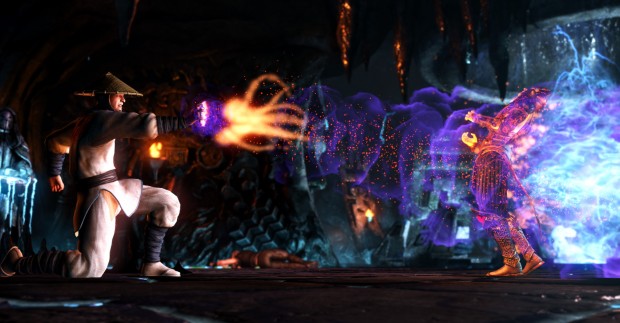Mortal Kombat X Review (Xbox One)
- Updated: 6th May, 2015

Mortal Kombat X sets a great standard for fighting game storytelling. The characters aren’t exactly complex but they all have their own set of problems, from family issues to age old clan rivalries. Along the way there’s a bunch of twists and turns; enemies become allies and allies become enemies as you smash your way through realm after realm. Newbies to the Mortal Kombat story are catered to with flashbacks to previous events, while veterans are shown cutscenes that refresh old rivalries between popular fighters, like Scorpion and Quan Chi. There are also some fresh new faces to root for.
The story is divided into 12 chapters, each with around four fights. The campaign mode of the game lasted me four-to-six hours, an average length for a fighter. That total includes almost two-and-a-half hours of cutscenes, interspersed with bizarre and inconsequential quick time events, presumably an attempt to make the cut scenes more interesting. It feels as if NetherRealm never had faith in their story and had to try to make it more exciting and engaging. Unfortunately, these quick time events don’t have any impact on the next battle; perfecting them doesn’t mean your opponent will have less health and failing them doesn’t mean you’ll suffer. However, you’re rewarded with icons for your player card that will offer you a perk, such as extra XP. The levels you gain unlock additional customizations for the player cards that appear next to your name online.
These cutscenes seamlessly transition into gameplay. There are no jarring loading screens between the fights making the game immersive and keeping you from being flung back into your miserable reality. I was impressed with the dialogue. It turned from witty to serious several times and often the characters seemed like genuine, three-dimensional people, a rare commodity in a fighting game.
 I did feel cheated, however, by the omission of some playable characters. Personal favourites Smoke and Bo Rai Chen, for example, both appear in the story, and yet aren’t playable. Even worse that this, Tanya and Rain are both opponents with their own unique fighting styles, but one you have to pay extra for and the other is simply unavailable. Why go to the trouble of animating and rendering a fighting character to not then offer him or her as playable?
I did feel cheated, however, by the omission of some playable characters. Personal favourites Smoke and Bo Rai Chen, for example, both appear in the story, and yet aren’t playable. Even worse that this, Tanya and Rain are both opponents with their own unique fighting styles, but one you have to pay extra for and the other is simply unavailable. Why go to the trouble of animating and rendering a fighting character to not then offer him or her as playable?
There are a bunch of new characters – most related in some way to the older characters. Cassie Cage and Jacqui Briggs, are both online casino kids of characters that have appeared in previous games. They’re a great addition because each one plays very differently; some are strength-based, others are speed-based, close range and long range. Their personal relationships with the older characters make it easy to invest in the story.
The DLC path the developers have taken offers the ability to unlock all custom items and perform easy fatalities: all you have to do is hand over real world cash. It’s not “pay to win” – you can’t buy any game-changing buffs or items – but any game where you can simply buy something that should take skill and practice and hard work to earn just doesn’t sit well with me. I know microtransactions are here and they’re staying, but I can still be a grumpy old man of 22 about it. And the game price is almost doubled if you buy the first DLC pack.
The fight animations are smooth and clean, and the characters seem to have much more depth and detail than other next-gen fighting games. A great addition is how lively the arenas are – there’s always something happening in the background and they have great depth. Objects can be used offensively or defensively, as weapons, platforms and as usable environment. In one arena, you can throw an old woman at your opponent. What’s not to enjoy?
 The online mode is split into three major game types: 1 v 1, team battles and King of the Hill. The team battles are a clever way to have you play with your friends. Instead of tagging out, you’re each pitted against an opponent on the other team, so the fights all take place at once. King of the Hill has you wait in turn to fight the “king”, who is the player that has won the most recent match. I was king for 7 matches and began to find people quitting early. NetherRealm deal with quitters by making their head explode and rewarding you a ‘Quitality’ win.
The online mode is split into three major game types: 1 v 1, team battles and King of the Hill. The team battles are a clever way to have you play with your friends. Instead of tagging out, you’re each pitted against an opponent on the other team, so the fights all take place at once. King of the Hill has you wait in turn to fight the “king”, who is the player that has won the most recent match. I was king for 7 matches and began to find people quitting early. NetherRealm deal with quitters by making their head explode and rewarding you a ‘Quitality’ win.
As a veteran gamer, I found the difficulty to be pretty much perfect: the AI learns as you fight so you can’t spam the same move, plus your computer opponents are capable of complex combos that are difficult to thwart. There’s a discreet difficulty setting option tucked in the options menu, so it’s welcoming to both hardcore players and newcomers alike.
Factions is a new feature. There are five in total: Lin Kuei, Shirai Ryu, Black Dragon, The Brotherhood of Shadow, White Lotus Society and Special Forces. The factions are always at war and each one has a special faction fatality. You do your part simply by playing: each match you play gives points to your faction. At the end of each week the faction with the most points is rewarded with a cosmetic item or special finisher. It’s a nice add-on but nothing that will really affect your gaming experience.
Towers make a triumphant return to Mortal Kombat X in several variants. Alongside the simple, classic tower where each fight wins you progression to another level, NetherRealm have introduced new ‘living’ towers which have special combat modifiers such as fast fighters or poison that constantly drains your health. The living towers are updated frequently so it’s rare you’ll do the same fight twice, and you can even challenge your friends to try and beat your tower score.
All in all, Mortal Kombat X is a shining example of what next-gen fighters should be: an interesting story with new characters, plenty of game modes to keep you entertained, and environments that almost breathe.


Follow Us!